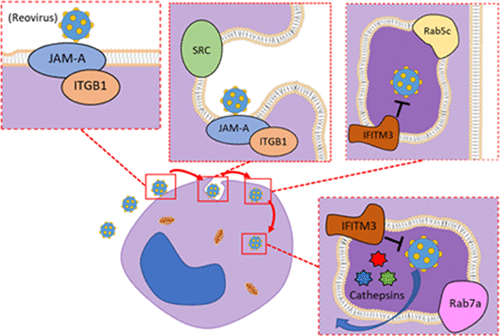当前位置:
X-MOL 学术
›
J. Proteome Res.
›
论文详情
Our official English website, www.x-mol.net, welcomes your
feedback! (Note: you will need to create a separate account there.)
Quantitative Proteome Responses to Oncolytic Reovirus in GM-CSF- and M-CSF-Differentiated Bone Marrow-Derived Cells.
Journal of Proteome Research ( IF 3.8 ) Pub Date : 2020-01-17 , DOI: 10.1021/acs.jproteome.9b00583 Michael A Giacomantonio 1 , Andra M Sterea 2 , Youra Kim 1 , Joao A Paulo 3 , Derek R Clements 1 , Barry E Kennedy 1 , Moamen J Bydoun 1 , Ge Shi 1 , David M Waisman 1, 4 , Steven P Gygi 3 , Carman A Giacomantonio 1, 5 , J Patrick Murphy 1, 6 , Shashi Gujar 1, 2, 7, 8
Journal of Proteome Research ( IF 3.8 ) Pub Date : 2020-01-17 , DOI: 10.1021/acs.jproteome.9b00583 Michael A Giacomantonio 1 , Andra M Sterea 2 , Youra Kim 1 , Joao A Paulo 3 , Derek R Clements 1 , Barry E Kennedy 1 , Moamen J Bydoun 1 , Ge Shi 1 , David M Waisman 1, 4 , Steven P Gygi 3 , Carman A Giacomantonio 1, 5 , J Patrick Murphy 1, 6 , Shashi Gujar 1, 2, 7, 8
Affiliation

|
The efficacy of oncolytic viruses (OVs), such as reovirus, is dictated by host immune responses, including those mediated by the pro- versus anti-inflammatory macrophages. As such, a detailed understanding of the interaction between reovirus and different macrophage types is critical for therapeutic efficacy. To explore reovirus-macrophage interactions, we performed tandem mass tag (TMT)-based quantitative temporal proteomics on mouse bone marrow-derived macrophages (BMMs) generated with two cytokines, macrophage colony stimulating factor (M-CSF) and granulocytic-macrophage colony stimulating factor (GM-CSF), representing anti- and proinflammatory macrophages, respectively. We quantified 6863 proteins across five time points in duplicate, comparing M-CSF (M-BMM) and GM-CSF (GM-BMM) in response to OV. We find that GM-BMMs have lower expression of key intrinsic proteins that facilitate an antiviral immune response, express higher levels of reovirus receptor protein JAM-A, and are more susceptible to oncolytic reovirus infection compared to M-BMMs. Interestingly, although M-BMMs are less susceptible to reovirus infection and subsequent cell death, they initiate an antireovirus adaptive T cell immune response comparable to that of GM-BMMs. Taken together, these data describe distinct proteome differences between these two macrophage populations in terms of their ability to mount antiviral immune responses.
中文翻译:

GM-CSF 和 M-CSF 分化骨髓来源细胞中溶瘤呼肠孤病毒的定量蛋白质组反应。
溶瘤病毒(OV)(例如呼肠孤病毒)的功效取决于宿主免疫反应,包括促炎巨噬细胞与抗炎巨噬细胞介导的免疫反应。因此,详细了解呼肠孤病毒与不同巨噬细胞类型之间的相互作用对于治疗效果至关重要。为了探索呼肠孤病毒-巨噬细胞的相互作用,我们对小鼠骨髓来源的巨噬细胞(BMM)进行了基于串联质量标签(TMT)的定量时间蛋白质组学,该巨噬细胞由巨噬细胞集落刺激因子(M-CSF)和粒细胞-巨噬细胞集落刺激因子(M-CSF)两种细胞因子产生因子(GM-CSF),分别代表抗炎巨噬细胞和促炎巨噬细胞。我们对 5 个时间点的 6863 种蛋白质进行了重复定量,比较了 OV 的 M-CSF (M-BMM) 和 GM-CSF (GM-BMM)。我们发现,与 M-BMM 相比,GM-BMM 促进抗病毒免疫反应的关键内在蛋白表达较低,表达较高水平的呼肠孤病毒受体蛋白 JAM-A,并且更容易受到溶瘤呼肠孤病毒感染。有趣的是,尽管 M-BMM 不太容易受到呼肠孤病毒感染和随后的细胞死亡的影响,但它们能够启动与 GM-BMM 相当的抗呼肠孤病毒适应性 T 细胞免疫反应。总而言之,这些数据描述了这两个巨噬细胞群在发起抗病毒免疫反应的能力方面的明显蛋白质组差异。
更新日期:2020-01-17
中文翻译:

GM-CSF 和 M-CSF 分化骨髓来源细胞中溶瘤呼肠孤病毒的定量蛋白质组反应。
溶瘤病毒(OV)(例如呼肠孤病毒)的功效取决于宿主免疫反应,包括促炎巨噬细胞与抗炎巨噬细胞介导的免疫反应。因此,详细了解呼肠孤病毒与不同巨噬细胞类型之间的相互作用对于治疗效果至关重要。为了探索呼肠孤病毒-巨噬细胞的相互作用,我们对小鼠骨髓来源的巨噬细胞(BMM)进行了基于串联质量标签(TMT)的定量时间蛋白质组学,该巨噬细胞由巨噬细胞集落刺激因子(M-CSF)和粒细胞-巨噬细胞集落刺激因子(M-CSF)两种细胞因子产生因子(GM-CSF),分别代表抗炎巨噬细胞和促炎巨噬细胞。我们对 5 个时间点的 6863 种蛋白质进行了重复定量,比较了 OV 的 M-CSF (M-BMM) 和 GM-CSF (GM-BMM)。我们发现,与 M-BMM 相比,GM-BMM 促进抗病毒免疫反应的关键内在蛋白表达较低,表达较高水平的呼肠孤病毒受体蛋白 JAM-A,并且更容易受到溶瘤呼肠孤病毒感染。有趣的是,尽管 M-BMM 不太容易受到呼肠孤病毒感染和随后的细胞死亡的影响,但它们能够启动与 GM-BMM 相当的抗呼肠孤病毒适应性 T 细胞免疫反应。总而言之,这些数据描述了这两个巨噬细胞群在发起抗病毒免疫反应的能力方面的明显蛋白质组差异。









































 京公网安备 11010802027423号
京公网安备 11010802027423号